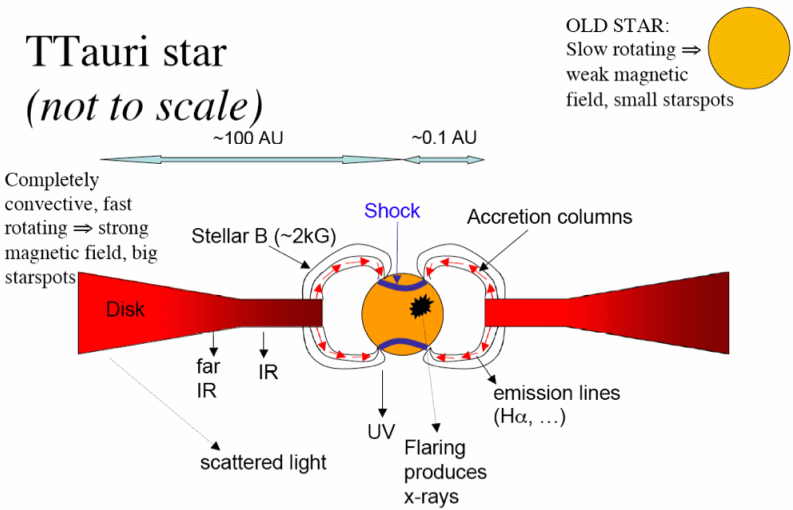Difference between revisions of "Finding cluster members"
m |
m |
||
| Line 11: | Line 11: | ||
Anatomy of a young star system (for reference) is to the right. | Anatomy of a young star system (for reference) is to the right. | ||
| + | |||
| + | =The Table= | ||
{| border="1" | {| border="1" | ||
| Line 42: | Line 44: | ||
* might not be flaring | * might not be flaring | ||
* will only find those stars that are X-ray active enough (might miss those that are deeply embedded or have big enough thick disks to block out the X-rays) | * will only find those stars that are X-ray active enough (might miss those that are deeply embedded or have big enough thick disks to block out the X-rays) | ||
| − | + | |- | |
| + | Outflows | ||
| + | ''(only present for the very youngest objects, Class Os and Is)'' | ||
| + | | | ||
| + | * Again, need to cover large areas (outflows can extend over many parsecs). | ||
| + | * Easily detectable in IRAC or optical emission line studies from the ground (search in ADS on “John Bally” to find lots such optical surveys) | ||
| + | * Signpost to star formation – really big, obvious literal pointer saying “there is a very young star right HERE” | ||
| + | * Real life examples of people using this method as a primary method for finding young stars: Walawender et al., “Multiple Outflows and Protostars near IC348 and the Flying Ghost Nebula,” 2006, AJ, 132, 467, Bally et al., “Irradiated and Bent Jets in the Orion Nebula,” 2006, AJ, 131, 473 | ||
| + | | | ||
| + | * orientation might not be good – if it’s pointing right at us, we’ll miss it. | ||
| + | * not all stars have jets | ||
| + | * sometimes hard to connect the maze of jets back to their source [2 main reasons: (a) central object often very embedded, and may be missed in optical and/or shallow surveys; (b) object precesses and moves, so jets twist and turn and don’t always point straight back to their source. In complicated regions (e.g., NGC 1333, see [http://www.spitzer.caltech.edu/Media/releases/ssc2005-24/index.shtml Spitzer image in press release archive]), this is particularly tough.] | ||
|} | |} | ||
Revision as of 23:17, 16 November 2007
This document is also known as "Luisa’s Table of Characteristics of Young Stars for Determining Cluster Members".
Introduction
Whenever we study stellar clusters the question is: Which objects are the cluster members? This is easier with young clusters than old because the young stars are noticeably different than older stars, so it is easier to distinguish the young cluster members from the surrounding interloper stars (foreground and background populations). This process has a nice analogy with people too... when the IC 2118 teacher team came to visit the SSC, we all went out to lunch at a local Mexican place. If someone who didn't know any of us walked into the restaurant while we were eating lunch, as a group of astronomers, we are (for the most part! ;) ) not distinctly different than the rest of the adults in there, so we’d be difficult to pick out as a distinct ‘cluster’ of people, especially while we weren’t all physically co-located -- some of us were in line, getting salsa, and/or at the table. But, if a group from a day care center had been there, it would have been immediately clearly obvious that the children were a group that was different than the rest of the people in the restaurant. Moreover, the amount of time a human spends as a child is short compared to their entire lifetime, and so it is with stars. You have to seek out the group of young stars/humans in order to study their development.
Astronomers use as many of the following characteristics of young stars as possible to determine cluster membership, and we will do the same.
After reading this table, if you now go back and look at Maria Kun’s original IC2118 papers, see how many of these items she’s listing in making her case that she’s found young stars in IC 2118. I haven’t done this. Have I missed any in the list below?
Anatomy of a young star system (for reference) is to the right.
The Table
Outflows (only present for the very youngest objects, Class Os and Is)| Characteristics | Pros | Cons |
| IR Excess
(IR is emitted by circumstellar matter) |
|
|
| (Flaring) X-rays
(young stars emit lots of X-rays because they are completely convective and fast-rotating, so they have lots of starspots and therefore lots of flares, big and small) |
|
|
|
|
